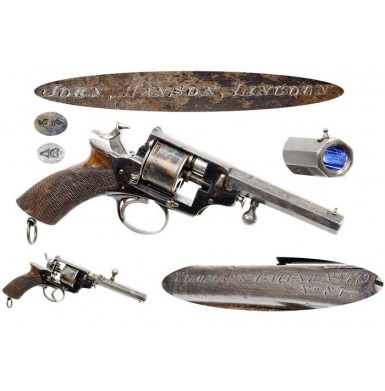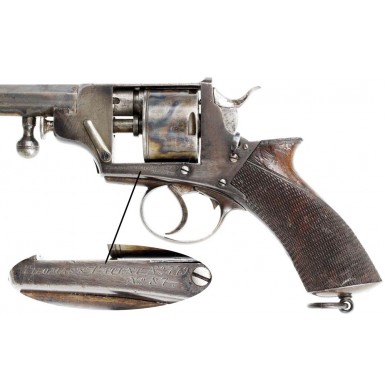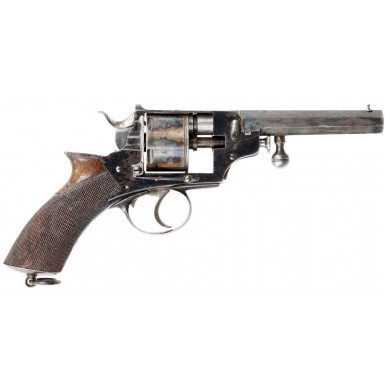With the introduction of successful self-contained metallic cartridges in the mid-19th century, the race began to “build the better mouse trap” for repeating handguns. Two basic types of metallic cartridge revolvers came to dominate the basic designs of the period. The first was the solid frame revolver that was loaded and unloaded one cartridge at a time via a gate on the side of the frame, typified by the Colt Single Action Army in America and early Adams and Tranter revolvers in Great Britain. The other primary design was a “break open” action that allowed for simultaneous extraction of spent cartridges and more rapid reloading. In America, the Smith & Wesson design predominated, while in Great Britain it was the Webley that best represented this type of revolver. While the top break system certainly had advantages in loading and unloading, it had limitations as well. The system was not well adapted to long cartridges or cartridges that had small rims. Longer cartridges meant a longer extraction system which was weaker and less reliable and small case rims had the potential to slip through the extractor star, fall back into the chamber and the revolver useless until the case could be punched out of the chamber. These two failings were the reason that the Smith & Wesson Schofield was not chambered for the standard service revolver ammunition, the .45 Colt cartridge. It was too long with too small a rim to function reliably with the extractor system. In an attempt to circumvent the design limitations of the break open action design, several competing “simultaneous’ extraction systems were patented around the world. The best known in the United States was that used by Merwin, Hulbert & Company. In Europe, the most successful design was that of Charles François Galand, and in Great Britain it was the design of John Thomas. All three systems used a similar concept, in that opening the action allowed the barrel and cylinder to be drawn forward on the cylinder arbor pin, which by a variety of methods removed the spent cartridges from the chambers and allowed unfired cartridges to remain in the action of the revolver. While the Merwin, Hulbert & Company design is well known to collectors, and most have at least heard of the French Galand patent design, the Thomas Patent Revolver remains a relatively obscure and unknown design to most collectors.
John Thomas was a gunsmith who worked for the Birmingham (England) based firm of Tipping & Lawden. Tipping & Lawden was a partnership between Thomas Tipping Lawden and Caleb Lawden, who established themselves as gun, rifle and pistol makers at 40 Constitution Hill in 1837, expanding to 40 & 41 Constitution Hill in 1852. In 1860, they added London location at 18 Buckingham Street. In addition to the usual production of military pattern muskets, rifles and sporting arms for the general gun trade both in England and abroad, the firm established itself as a major manufacturer of handguns in Great Britain. They produced double action percussion revolvers under Willian Harding’s 1858 patents for Deane & Son in London (these were of the “Deane-Harding” pattern) and in 1859 procured the rights to manufacture Sharps’ Patent four-barrel pepperbox revolvers under a licensing agreement with Sharps. Tipping & Lawden also secured their own patents during 1861 and 1862 for a breechloading mechanism (in both percussion and pin fire), a dropping barrel breech loader (with John Thomas) and a cane gun. On March 13, 1869 John Thomas, who was employed as a manager at Tipping & Lawden, was granted British Patent 779 / 1869. His patent was a for a cartridge revolver with a simultaneous extraction system. The patent actually covered three variations of the mechanism, but it appears that only the 1st type of action was produced in any quantity. Thomas entered into an agreement with Tipping & Lawden to produce the revolvers of his design, which they did from about 1869 until they were bought out in 1877 by P. Webley & Son. The Thomas Patent revolver was a solid frame design with a longer than normal frame, which allowed enough space for the cylinder to slide forward about “ of an inch. The revolver loaded in a convention manner through a loading gate on the right rear of the frame. However, a very different system was used to unload the revolver. A small spring at the lower front of the frame was depressed, allowing the shooter to use the large, bulbous lug under the barrel to rotate the barrel counterclockwise through 180 degrees. This freed the barrel to be drawn forward which pulled the cylinder forward at the same time as well. A stationary star shaped extractor at the rear of the frame held the cartridges by their rims, and after the cylinder was pulled forward, any empty cartridges could be shaken loose, as they were no longer supported by the cylinder chambers. Unfired cartridges remained in place, as their exposed bullets were still within the chamber. The process of opening the revolver in this way created a large amount of torque, which helped to dislodge any stuck casings from the chambers and made for a very reliable extraction system. To close the action, the barrel was simply pushed back into its normal position and rotated clockwise to lock the action closed. The balance of the design was a typical English pattern double-action (“self-cocking”) revolver of the period, with the often-encountered exposed sear release at the upper rear of the triggerguard. The one exception was the inclusion of an interesting “hammer safety” device. This small wing shaped screw at the upper left rear of the frame served as both a hammer locking safety and a de-cocking device. With the screw fully tightened the action was locked and the hammer could not be cocked either manually or by pulling the trigger. By loosening the screw, the action functioned normally. If the hammer was fully cocked and the shooter wanted to de-cock the revolver, the screw could be tightened, and the trigger pulled. This would release the sear and the hammer, but the hammer would remain in the cocked position, supported by the hammer safety screw. Slowly releasing the pressure on the screw by loosening it would allow the hammer to drop into a safety notch, keeping the firing pin from contacting the primer of the cartridge in the chamber. This same safety system was utilized on other revolvers produced by Tipping & Lawden. The Thomas Patent revolvers were produced in the usual British centerfire cartridge calibers of the period .450, .380 and .320, which were essentially equivalent to the older percussion calibers of 54-bore (about .44), 80-bore (about .38) and 120-bore (about .33). The smaller caliber revolvers are extremely rare, and even the large bore guns are quite scarce, as most estimates place the total production of Thomas Patent revolvers at less than 1,500. In general, the guns had octagonal barrels, checkered one-piece walnut grips and a lanyard ring in the butt. Finish was usually blued frames and barrels, with case hardened or blued cylinders. However, case hardened barrels are known as well. The guns rarely bear Tipping & Lawden markings, but usually have a Thomas’ Patent mark on the left side of the frame, along with the patent number with a serial number underneath. Topstraps are usually marked by the retailer of the guns. The Thomas system was robust and worked very well, but apparently suffered from lack of sufficient marketing to compete with the better-known Adams, Tranter and Webley names of the period. It is interesting, however, to note that Webley purchased Tipping & Lawden in 1877, essentially removing a competitor from the market, while at the same time acquiring their machinery, inventory and what workforce they chose to keep. As Webley was the most successful English revolver maker of the period, the acquisition of a firm that was producing a high-quality competitor made perfect sense. However, the new owners did not renew the Thomas Patent, which had lapsed during 1876, but was still eligible from renewal. Webley apparently did not see the need to prevent anyone else from producing a revolver upon the Thomas principles, and must not have considered it a major threat to the sales of their top break revolvers. After the sale of Tipping & Lawden, John Thomas went on to work on his own as a gunmaker. He had obtained another patent in 1871 for a “wedge bolt” action shotgun and apparently produced some quantity of these guns in his own shop, which were subsequently marked with other retailer names. Thomas was located at 66 Slaney Street in Birmingham from 1879-1883, and moved next door to 67 Slaney Street in 1884. He disappears from the directories after that year, and eventually became a footnote regarding obscure revolver designs. It would not be unfair to consider his revolvers to be the English equivalent to the Merwin, Hulbert & Company designs in America, a well- designed and well-made handgun that suffered from lack of promotion and market penetration, rather than a lack of quality, which eventually resulted in the failure of the system.
Offered here is a VERY FINE+ condition example of a scarce and early production Thomas Patent Revolver. The gun is one of the large-bore, .450 CF handguns, with a five-shot cylinder and a 5 ““ octagonal barrel. The revolver is clearly marked in two lines on the lower left side of the frame: THOMAS’ PATENT No 799 over No 87. The “799” refers to the actual patent number assigned to Thomas in 1869, and “87” is the serial number. The topstrap is engraved with the retailer mark: JOHN HANSON, LINCOLN. John Hanson was a gunmaker and retailer located at 244 High Street in Lincoln (Lincolnshire) from about 1860 to 1883. The revolver bears the usual London commercial proof marks of the period, a (CROWN) / GP and a (CROWN) / V, and they are found between the cylinder chambers and on the bottom of the barrel. This indicates that the revolver originated in the Tipping & Lawden London manufactory. All of the markings remain crisp, sharp and very legible.
As previously noted, the revolver is in VERY FINE+ condition and retains much of its original finish. The revolver has a color case hardened cylinder and barrel, with a blued frame. The barrel retains about 65%+ original vivid case coloring with some fading, dulling and wear. The largest area of loss is along the left side of the barrel, near the frame juncture, where some small scratches and scuffs are present as well. It is possible that some oxidation occurred here and was subsequently cleaned off. The areas of the barrel where the color had faded or worn have a dull pewter gray patina. There is some lightly scattered oxidized discoloration and staining flecked along the barrel, but it is minimal and blends well with the mottled coloring. The cylinder retains about 80%+ vivid case coloring and is very striking. There is some lightly oxidized discoloration and staining present on the cylinder as well, mostly on the front and rear faces. The frame retains about 35% of its original bright blued finish with the majority of the fading, flaking and loss on the left side of the frame. The areas of fading and loss have a similar dull pewter gray patina as found on the barrel on the forward portion and a smooth plum-brown patina at the rear of the frame. Again, small areas of minor oxidized discoloration and staining are present on the frame, as well as some flecks of minor surface roughness and very minor pinpricking. The blued triggerguard and buttcap retain only traces of original blue, and show a smooth plum-brown patina as well. The hammer is finished it the white and shows flecks of oxidized discoloration on its surfaces. The bore of the revolver is in EXCELLENT condition and remains bright and shiny, with only some minor frosting in the grooves. The bore is rifled with four broad grooves and four narrow lands, that all remain quite crisp and sharp. The revolver retains its original lanyard ring in the butt and the original front sight in the dove tail on the top of the barrel near the muzzle. The revolver is mechanically EXCELLENT and functions perfectly in every way. The double action mechanism functions flawlessly and the revolver times, indexes and locks up exactly as it should. The unique hammer safety mechanism is fully functional as well. The barrel locks securely into place as it should and when the frame released is pressed, the barrel can be rotated and pulled forward to open the action exactly as it was designed to nearly 150 years ago. This entire operation still works smoothly and locks up tight as a drum. The loading gate operates smoothly and correctly as well. The checkered one-piece walnut grip remains in about FINE condition as well. The grip is solid and complete and free of any breaks, cracks or repairs. The grip shows some scattered bumps, dings and bruises from handling and use, but no abuse, and the majority of the checkering remains crisp and sharp.
Overall this is a really wonderful example of a very scarce Thomas’ Patent Revolver that is 100% complete, correct and original in every way. The gun retains most of its original finish and the color case hardened barrel and cylinder are very striking in appearance. The revolver and its unique mechanism operate flawlessly, and the gun remains in crisp condition throughout. This is a very interesting gun and wonderful example of a scarce variant in the quest in improved system for simultaneous extraction. While never as successful as the competing designs of the time, the fact that similar systems were developed and marketed in America and on the Continent during the same period speaks to the practicality of the system. This would be a great addition to any advanced collection of early cartridge revolvers, English cartridge revolvers or any display that follows the mechanical advances in cartridge revolver design. From a systems standpoint, a display with a Merwin, Hulbert & Co revolver a Galand revolver and a Thomas’ Patent revolver would be very interesting and educational. These Thomas’ Patent handguns rarely come up for sale, and when they do they often have condition issues or mechanical issues with the hammer safety. This gun is 100% in every way and will be a great addition to your collection of 19th century cartridge handguns.
SOLD








